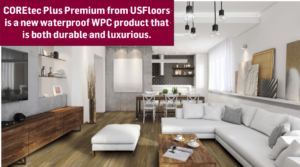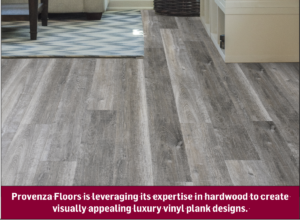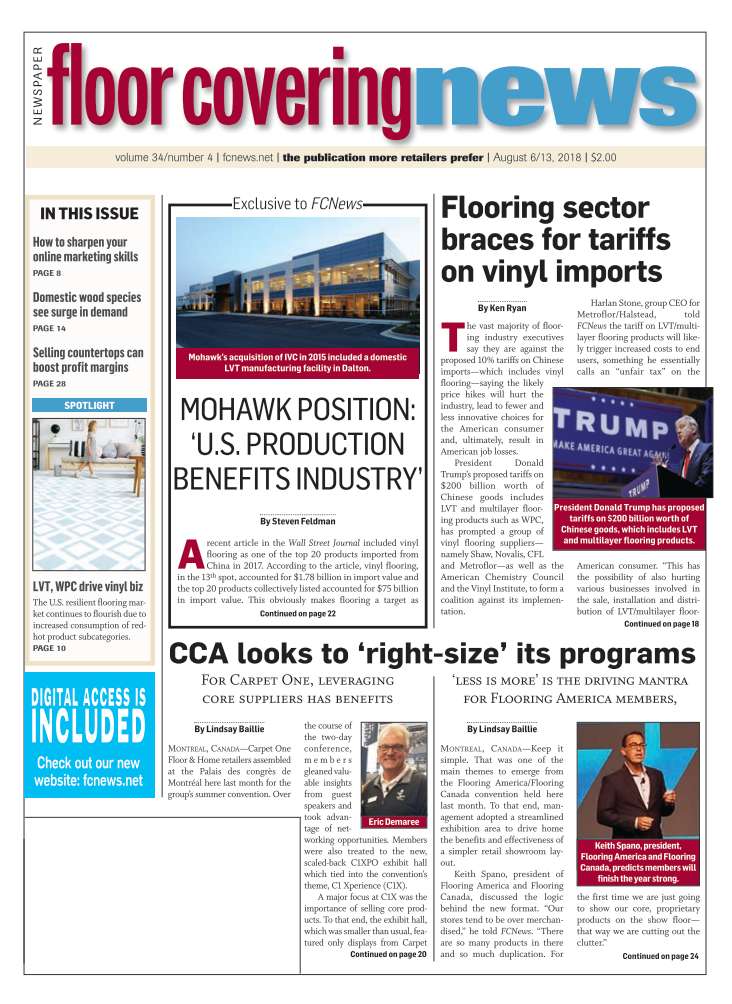August 6/13, 2018: Volume 34, Issue 4
By Lindsay Baillie
In the first six months of 2018, the resilient category has shown no signs of slowing down. In fact, some industry executives predict even greater growth for the segment in 2018 above and beyond the strides made in 2017. In keeping with last year, industry observers attribute the category’s aggressive, record-setting growth to innovations in WPC and SPC.
Some executives also see factors outside the industry contributing to the category’s success. “We believe there are several factors for resilient’s growth,” said Steve Ehrlich, vice president of sales and marketing, Novalis Innovative Flooring. “On a macro level, the overall U.S. economy is strong—GDP may reach 4%—and the housing market, both new and re-sale, is strong. All of that is good, but what makes it successful is a resilient product category coming on the scene that satisfies consumer needs so well.”
Based on FCNews research, residential LVT and its subcategories were the products to successfully satisfy consumer needs in 2017. In fact, residential LVT finished 2017 with an estimated $1.888 billion in revenue, which represented 73% of total residential resilient sales. In terms of volume, the category captured 1.379 billion square feet, or 48.1% of residential resilient volume. What’s more, WPC and SPC claimed 45.8% of residential LVT dollars and 31.8% of the category’s volume.
“LVT is a product that has come at the right time,” said David Sheehan, senior vice president, product management, Mohawk Industries. “It’s providing the right value proposition to the consumer. Retailers have really embraced this notion of leveraging waterproof, which appears to be resonating in the minds of consumers.”
Rigid products, according to Sheehan, boast physical properties that make it attractive to homeowners and end users. “It tends to be thicker, and thickness is viewed as something from the consumer that equates with high quality. It seemingly has solved some installation concerns on behalf of some retailers and flooring installers vs. its flexible counterpart.”
Much of the trends seen in 2017 have carried over into the first half of 2018. Sheet is still relatively flat; LVT is seeing growth with WPC and SPC; waterproof is still piquing consumer interest. While the category has been up overall, observers say margins are deteriorating on entry-level products. “Product awareness has helped create a much wider audience to which we can sell LVT,” said Michael Raskin, founder and CEO, Raskin Industries. “There is excitement in the category and around the new types of flooring coming out of it.”
From this sustained consumer excitement, flooring executives are bullish about the category’s prospects in 2018. “Across all segments of our business—from specialty markets, hospitality and education to multifamily and single-family homes—Shaw Industries’ and USFloors’ resilient flooring continues to consistently outperform expectations,” said Piet Dossche, president of USFloors and executive vice president of hard surface, Shaw. “Resilient flooring enables consumers to incorporate the desired looks into their homes without worrying their flooring will be scratched or damaged by water. USFloors’ customers and their consumers often remark to us on how much they appreciate LVT’s ease of maintenance and its scratch-resistant and waterproof qualities.”
Sheet’s staying power
According to statistics compiled by FCNews, sheet was down 2.8% from $596.1 million in 2016 to $579 million in 2017. The category also saw a 4.2% drop in volume. Sheet’s slowdown, observers say, is a result of the rise in WPC and SPC—not only because of the latter two’s waterproof stories, but also the perceived value of a rigid core vs. a flexible product.
“In a way, one of the secondary impacts of a successful product like rigid is it sometimes causes an overreaction in the market,” Mohawk’s Sheehan explained. “People begin to say, ‘OK I’m selling a lot of rigid, so I need to put more rigid in my store,’ and they therefore go ahead and create an imbalance in their product portfolio.”
Sheet’s slowdown is also attributed to the fact that it is a mature category, says Michael Harris, product manager, Armstrong Flooring. “Sheet vinyl is feeling pressure from LVT, primarily on the new construction side, but it is still a great residential remodel product and continues to see strength there,” he said. “Investments in manufacturing, processes and new technology are being made with a strategic view.”
 Another key factor is the current installation crisis, which makes installing sheet vinyl a harder task. As Kurt Denman, chief marketing officer and executive vice president, sales, Congoleum, explains, “It is certainly no secret that a sheet installation requires a specific skill set beyond that of something like LVT. And it is essential that we, as manufacturers, understand the market and consumer preferences so we can guide the evolution of resilient sheet to ensure a strong and relevant future for the category.”
Another key factor is the current installation crisis, which makes installing sheet vinyl a harder task. As Kurt Denman, chief marketing officer and executive vice president, sales, Congoleum, explains, “It is certainly no secret that a sheet installation requires a specific skill set beyond that of something like LVT. And it is essential that we, as manufacturers, understand the market and consumer preferences so we can guide the evolution of resilient sheet to ensure a strong and relevant future for the category.”
Despite another year of relatively flat performance, sheet is still a viable category. That’s according to flooring executives, who believe the category is necessary for specific commercial sectors as well as residential DIY projects. “Our research shows, with both consumers and retailers, that sheet vinyl is indeed a viable category,” Sheehan said. “There is a specific sheet vinyl buyer, and you can argue it’s regional in nature, but that’s fine. There is a sheet vinyl buyer who is walking into stores today and being traded or switched to a rigid product when she would have been perfectly fine and satisfied with a sheet vinyl product.”
Two ways to combat a sheet vinyl buyer being converted to a rigid product is through updated visuals and proper education, resilient manufacturers say. “The most important part is to push the visuals,” said Jimmy Tuley, vice president of residential resilient, Mannington. “We’ve been able to produce visuals in sheet vinyl that you just can’t replicate in LVT or any other hard surface without spending a ton of money. We just need to make that an attractive part of the offering as much as we can.”
To help create an even playing field, Mannington mounts its sheet vinyl to hard boards. This way, according to Tuley, consumers can see what it will look like once it’s installed, thereby helping sheet compete against a rigid product’s perceived value.
In terms of education, manufacturers are looking for ways to engage with today’s buyers. “Gaining awareness with younger customers will be an important key to the sheet vinyl category while maintaining retail space against the popularity of LVT, WPC and SPC,” said Jon Gittrich, vice president product management, Tarkett. “We are increasing our social media and exposure on home improvement shows.”
LVT maintains its lead
It should come as no surprise that LVT and its subcategories, WPC and SPC, are seeing continued momentum through the first half of 2018. As the main drivers of residential resilient sales, their success begs the question, where does the LVT category go next?
Industry observers see the trio continuing to innovate in terms of style, design and features. “There are a couple of different innovations that will come in both construction and newer performance stories,” said Mannington’s Tuley. “But even bigger than that, innovation will be similar to sheet vinyl—continuing to make vinyl products that mimic real products exceptionally well. If you look at the LVT category over the past 10 years and compare a sample of LVT from 10 years ago to today, there is a remarkable visual difference.”
Novalis sees seemingly endless possibilities with WPC and SPC because the products are still relatively new. “Digital printing, larger size tiles and planks, wall applications and increased physical performance characteristics are just some of the changes that will help keep driving sales in both SPC and WPC categories,” Ehrlich said. “Innovation at Novalis has led to exciting new looks and styles we brought to market in our Serenbe collection this year.”
As relatively new products, WPC and SPC also have the opportunity to continue answering the needs of retailers and consumers.
“I foresee technical advancements in this category, allowing printed visuals to evolve from a hardwood to a ceramic tile visual,” USFloors’ Dossche said. “For consumers desiring a ceramic tile look, the skill set needed to install that product is hard to find given the current shortage of qualified tile installers. Stone-look LVT could answer a number of needs, such as do-it-yourself installation and quicker installation in homebuilding.”
The success of this category is also reliant on better machines, faster technology and overall improved production, according to Amy Sadler, national sales manager, EarthWerks. “We are optimistic that capacity and speed to market are only going to continue to progress, thus driving the capabilities in this segment,” she added.
Beyond technological innovation with respect to product attributes, the category’s success also relies on proper education. “Retail training and passing valuable information to the consumers is important,” Raskin said. “Innovations are great, but with so much change sometimes the products aren’t explained properly in the marketplace.”
WPC, SPC steal share
As with any new and successful product, both WPC and SPC are starting to steal market share from other products in the industry. At a macro level, these two products are helping resilient steal share from laminate and other hard surfaces as well as carpet. At a micro level, WPC and SPC are stealing share from sheet vinyl and traditional LVT, experts say.
“These types of products are taking share from virtually every category, including laminate, hardwood and ceramic,” said Larry Browder, chief sales and marketing officer, Karndean Designflooring. “They require less subfloor preparation, can go over existing hard surface floors—thus reducing/eliminating tear-out costs—and cause less upheaval and down time on the job site. All of this results in lower installation costs for the homeowner or end user and potentially less hassles or callbacks for the retailer and installer—provided they are using a quality product and installing the floor correctly.”
Along with the ease of installation, WPC and SPC solve certain issues other products cannot. “It has the maintenance attributes that all families are looking for, making it ideal for kid-friendly and pet-friendly spaces,” EarthWerks’ Sadler said. “Style and design have drastically improved, and when you add the waterproof and performance capabilities, you have the perfect story for the ideal product.”
Domestic vs. imports
Being that resilient—specifically LVT, WPC and SPC—is such a sought-after category, manufacturers agree that a balance between domestic production and importation will always exist. Even though many manufacturers still import, there are a number of domestic facilities being built to create LVT and now WPC and SPC locally.
“We believe in the viability of domestic production,” Mohawk’s Sheehan said. “After we purchased IVC and started leveraging its U.S. assets, we were very aggressive in making sure we got our flexible LVT plant up and running. We’re continuing that same tradition with our new rigid plant.”
Sheehan added that while Mohawk is focusing on domestic production, it still understands the need to supplement its product offering with what he calls “good partner relationships with our supplier partners in Asia.”
Mohawk is not the only manufacturer investing in domestic production. Armstrong Flooring’s state-of-the-art facility in Lancaster, Pa., as well as a portion of its plant in Stillwater, Okla., are being used to produce resilient flooring. “We have invested in the domestic production of LVT to produce resilient flooring in a cost-effective manner, improve styling and be more responsive in servicing key market segments with inventory,” said Jeremy Kleinberg, senior product  manager. “We expect to continue to offer both a mix of domestic production and sourced product to best meet our customers’ needs.”
manager. “We expect to continue to offer both a mix of domestic production and sourced product to best meet our customers’ needs.”
While domestic production continues to grow, industry observers explain there is not enough capacity in the U.S. to successfully fulfill consumer demands. “As of now, I think domestic production will supplement overseas production,” Raskin stated. “Getting production lines up and running has been difficult for larger U.S.-based operations, so they still rely on outsourcing from Asia. The demand has grown considerably, but there hasn’t been the fastest momentum from domestic plants; a huge surge in demand creates a strong need for overseas production. Unless demands decreases—which may or may not happen if a tariff is imposed—overseas production will still be required.”
What’s next?
As the hottest segments within the resilient category continue to generate consumer interest and, naturally, sales, suppliers expect to develop new innovations to maintain that momentum. Case in point is the new resilient portfolio from Provenza Floors, which in the past has been known primarily for its expertise in hardwood flooring production. As it turns out, the company is utilizing its vast experience on the wood product development side to create extremely realistic vinyl flooring offerings.
“Many people have entered the LVP market, but what we are seeing is a repeat of patterns,” said Ron Sadri, principal owner. “What we decided to do, in order to differentiate ourselves in the market, is digitally scan our real hardwood flooring products and create our own resilient looks that are exclusive to Provenza. Specifically, we will be adding about 14 new SKUs—all long boards in primarily oak looks—to our Moda Living line of luxury vinyl planks.”
But the company is not stopping there. Provenza has also developed what it calls an engineered stone powder composite core product that features an LVT top layer. Highly dense and durable, but still affordable, the new line scored high marks in focus groups and dealer and distributor previews. “We are taking what we believe are the best visuals for consumers and designers that are price driven, and yet maintain the same integrity and quality for which Provenza is known,” Sadri stated.
In addition to more manufacturers entering the category, existing resilient suppliers are competing with new introductions. “While not technically an LVT product, the introduction of CLEO is a perfect example of innovation in hard surface that has been met with incredible enthusiasm,” Congoleum’s Denman said. “It is different in every way and is set to be a game changer for the industry. CLEO is a first-in-class, eco-forward construction that is entirely PVC free and features a mineral composite core that is 85% domestically sourced limestone coupled with solvent-free, high-fidelity digital imaging and a high-performance, ultra-clear, VOC-free top coat.”
Most resilient manufacturers see the success of LVT, WPC and SPC continuing well into 2019. Novalis’ Ehrlich sees sales for these products continuing to rise as more displays are placed in showrooms and as more consumers begin to share the benefits of resilient flooring. “More retail and commercial segments are embracing the category, so we see a very bright forecast for the remainder of 2018 and 2019,” he stated.

